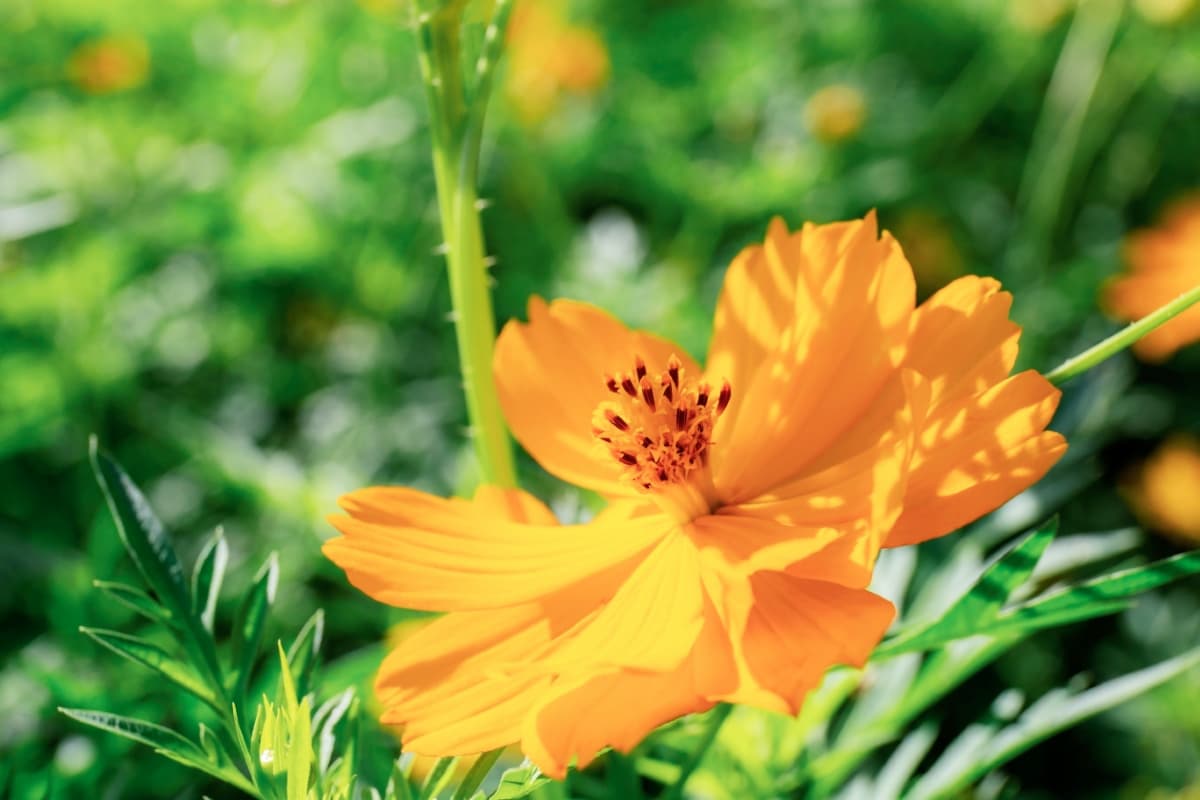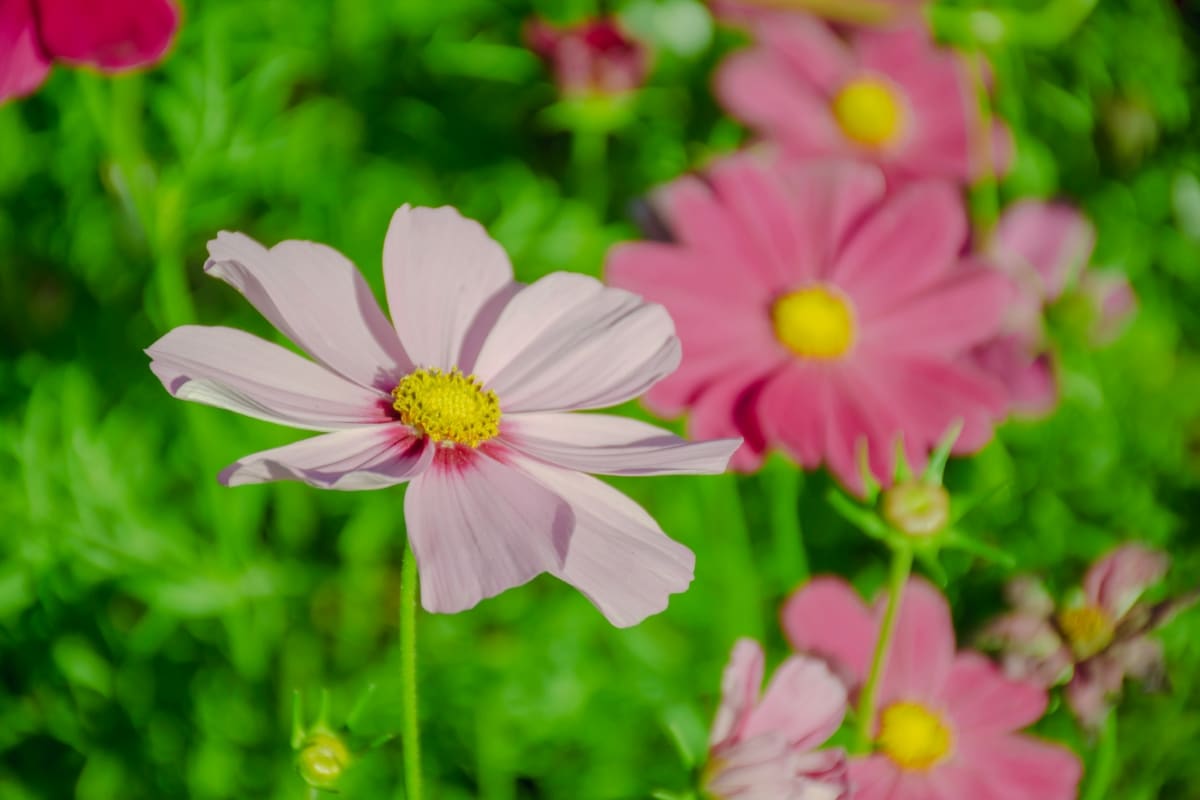Cosmos is a beautiful flowering plant that is native to Mexico. It is popular among gardeners because of its easy care and striking blooms. If you are a beginner who wants to plant, grow, and care for the cosmos, here are some instructions to help you get started.

How to Grow and Care for Cosmos Flowers
Step-By-Step Guide to Planting Cosmos Flowers
- Cosmos flowers thrive in full sun. Choose a spot that gets exposure to at least six hours of direct sunlight daily.
- Cosmos flowers prefer well-draining soil. Mix organic matter such as compost or aged manure into the soil to improve its quality and drainage.
- Cosmos seeds can be directly sown into the garden in the spring after the last frost. Sow the seeds to a deep of ¼ inch and 2-3 inches apart.
- Water the Cosmos seeds immediately after planting and maintain the moisture in the soil until the seeds germinate, which usually takes 7-21 days.
- Once they are 2-3 inches tall, thin them to a spacing of 12-18 inches apart to allow room for growth.
Best Soil and Sunlight Requirements for Cosmos Plants
Soil Requirements
Cosmos plants prefer well-draining soil that is rich in nutrients. pH range between 6.0 and 7.0 is ideal. Mixing compost or other organic matter into the soil before planting is recommended. This will help to provide the necessary nutrients for healthy growth. Avoid soils that are heavy in clay, as they can cause waterlogging, leading to root rot.
Sunlight Requirements
Cosmos plants require full sun to thrive. They need at least six hours of direct sunlight daily to produce the best blooms. The plants may become leggy and produce fewer flowers if planted in partial shade. It is important to ensure that other plants or structures do not shade them during the day.
Watering Schedule for Healthy Cosmos Growth
- Watering time: Watering your Cosmos plants early or late in the evening when temperatures are cooler. This can prevent water from evaporating too quickly and ensure the plants have enough time to absorb the needed water.
- Watering frequency: Water your cosmos plants deeply once a week. This will help encourage deep-root growth and prevent water from evaporating too quickly.
- Watering amount: Aim to provide about an inch of water to the soil around the plant’s base. Avoid watering the plant leaves, as this can lead to disease.
- Soil moisture: Check the soil’s moisture level before each watering. Stick your finger about two knuckles into the soil. If the soil is dry at this depth, it’s time to water. If the soil feels moist, wait a day or two before checking again.
Pruning Techniques for Maintaining Cosmos Plants
- Deadheading: This involves removing spent blooms before they can go to seed. Deadheading encourages the plant to produce new blooms, resulting in a longer flowering season.
- Pinching: This technique involves using your fingertips to pinch off the tips of young stems. Pinching can help to promote bushier growth and discourage legginess.
- Shearing: This involves using pruning shears to cut back the entire plant. Shearing can be useful for maintaining the shape and size of your cosmos plants. However, it’s important not to shear too much at once, as this can shock the plant and inhibit growth.
- Thinning: This technique removes entire stems or branches from the plant. Thinning can be useful for improving air circulation and reducing the risk of disease.
In case you missed it: An Effective Guide to Grow and Care for Coneflowers: Planting Instructions

How to Prevent Common Pests and Diseases in Cosmos
Preventing Pests
- Keep your garden clean and tidy. Remove any dead leaves or debris that may attract pests.
- Use a natural pesticide to keep pests at bay. Neem oil is a popular option for organic pest control.
- Allow beneficial insects like ladybugs and lacewings to reside in your garden. These insects will help to control pest populations naturally.
- Plant companion plants like marigolds, which can repel pests with their scent.
Preventing Diseases
- Avoid overcrowding your cosmos plants. Space them out properly to allow for good air circulation.
- Water your plants properly. Overwatering can lead to fungal diseases like powdery mildew.
- Practice good garden hygiene. Use clean tools and containers to avoid spreading diseases.
- Consider using a fungicide if you notice signs of disease on your plants.
Cosmos Companion Plants for a Vibrant Garden
- Marigolds: Marigolds are the best companion plant for the Cosmos because they help to repel harmful insects and attract beneficial ones. They also have a similar growth habit, making them an excellent choice for planting alongside the Cosmos.
- Zinnias: Zinnias are another great option for planting alongside Cosmos. They have similar appearance and growth habits, and their bright colors can complement the hues of cosmos flowers.
- Salvia: Salvia is another great companion plant for the cosmos. It is drought-tolerant and can help to attract pollinators to your garden.
- Lavender: Lavender is a fragrant and beautiful plant that can complement the colors of cosmos flowers. It is also a great option for attracting bees and other pollinators to your garden.
Seasonal Maintenance Guide for Cosmos Flowers
Summer Maintenance
During the summer months, your cosmos flowers will be in full bloom. To keep them looking their best, deadhead the spent flowers regularly. Additionally, water your cosmos flowers regularly, especially during hot and dry weather.
Fall Maintenance
Preparing your cosmos flowers for the cooler weather ahead is important as the summer ends. Begin by cutting back any dead or damaged foliage, and apply mulch around the plant’s base to help protect the roots from frost damage.
Winter Maintenance
During the winter months, your cosmos flowers will go dormant. Begin by cutting back any remaining foliage and removing debris around the plant. It would help if you also considered covering your cosmos flowers with a layer of straw or other protective material to insulate them from the cold weather.
Troubleshooting Common Issues in Cosmos Cultivation
Failure to Germinate
T here are several reasons why this may occur. One reason may be that the seeds were not properly stored. Storing seeds in a cool, dry place is important to prevent this. Another reason may be that the seeds were planted too deep or not deep enough. Following the instructions on the seed packet for optimal planting depth is important.
Yellowing Leaves
Yellowing leaves tell that the plant is not receiving enough water or nutrients. To address this issue, ensure the plant receives adequate water and nutrients.
Pest Infestations
Cosmos plants, including aphids, spider mites, and thrips, can attract pests. Identify the problem causing pests and use the appropriate treatment to address pest infestations. This may include using insecticidal soap and neem oil or introducing natural predators like ladybugs.
Stunted Growth
Another common issue in cosmos cultivation is stunted growth. This is caused by a lack of sunlight, poor soil quality, or overcrowding. To address this issue, ensure that the plants receive enough sunlight and that the soil is well-draining and nutritious. Harvesting and Preserving Cosmos Seeds for Future Planting
In case you missed it: How to Grow and Care for Jade Plants: Planting Instructions

Conclusion
By following these instructions, you can easily plant, grow, and care for the cosmos. With their beautiful blooms and easy-to-care-for nature, the cosmos are a great choice for beginners and experienced gardeners alike.
- Feed Your Flock for Less: Top 10 Tips to Save on Chicken Feed
- Ultimate Guide to Ossabaw Island Hog: Breeding, Raising, Diet, and Care
- Hatching Answers: The Top 10 Reasons Your Chickens Aren’t Laying Eggs
- Eggs and Economics: Breaking Down the Cost of Raising Backyard Chickens
- Defend Your Greens: Proven Methods to Keep Iguanas Out of Your Garden
- Ultimate Guide to Cinnamon Queen Chicken: A Comprehensive Guide for Beginners
- Ultimate Guide to California Tan Chicken: Breeding, Raising, Diet, Egg-Production and Care
- Ultimate Guide to Marsh Daisy Chicken: Breeding, Raising, Diet, and Care
- 10 Types of Chicken Farming Businesses You Can Start for Profits